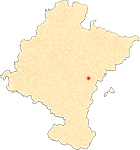Parish Church of San Pedro de Aibar
Santo Cristo del Amparo
The Santo Cristo del Amparo de Aibar is, both for its devotion and its quality, a focus of attention and special interest in the parish of San Pedro. This Gothic crucifix, dated around 1350 approximately, is a good example of mid-14th century imagery, sample . In contrast to the Romanesque crucifixes, where the main purpose was to represent the majesty of Christ on his throne, here we see a sorrowful and dying Jesus. In this sense, the king's crown is replaced by a braided crown of three strands. On the other hand, the four Romanesque nails are replaced by three nails, with the feet pierced by a single nail, a characteristic that allows us to ascribe the image to the Gothic period, the style to which this innovation is attributed. It is an upright Christ of slender proportions in which the influences of some French and Italian crucifixes are evident. These features allow Fernández-Ladreda to link it to the so-called "slender crucifixes" of the Navarrese-Catalan-Aragonese area. It is therefore an image of great quality compared to other existing examples that have undergone significant transformations.
The Santo Cristo has been the object of special veneration since ancient times in the town and the surrounding area, as can be seen at test when one of its feet was covered with silver in 1527. Its origins are shrouded in legend and tradition, which suggest that it was brought from Jerusalem by the knights from the town who accompanied King Theobald II of Navarre. The image is linked to the fight against public calamities such as droughts or plagues and is associated with miracles. There is also evidence that in the 17th century the Brotherhood of the Vera Cruz held services in honour of the Christ. In fact, it was the patrons of this brotherhood who commissioned the rich baldachin to house the image from the Aragonese artist Pedro de Arriaga in 1713. The staircase in front of it is a modern work by a son of the town. Testimony to the popularity of the Christ is also the engraving made at the beginning of the 19th century by an engraver called Vergara, possibly Marcos Vergara.
ARAGONÉS, E., "El románico de Sangüesa", El Arte en Navarra, volume 1, Pamplona, Diario de Navarra, 1994, pp. 65-80.
FERNÁNDEZ GRACIA, R., ANDUEZA UNANUA, P., AZANZA LÓPEZ, J. and GARCÍA GAINZA, M.C., El arte del Barroco en Navarra, Pamplona, Gobierno de Navarra, 2014.
FERNÁNDEZ GRACIA, R., ECHEVERRÍA GOÑI, P.L. and GARCÍA GAINZA, M.C., El arte del renacimiento en Navarra, Pamplona, Gobierno de Navarra, 2005.
FERNÁNDEZ-LADREDA, C., MARTÍNEZ DE AGUIRRE, J. and MARTÍNEZ ÁLAVA, C.J., El arte románico en Navarra, Pamplona, Gobierno de Navarra, 2004.
FERNÁNDEZ-LADREDA, C., MARTÍNEZ ÁLAVA, C.J., MARTÍNEZ DE AGUIRRE, J. and LACARRA DUCAY, M.C., El Arte Gótico en Navarra, Pamplona, Gobierno de Navarra, 2015.
GARCÍA GAINZA, M.C. and ORVE SIVATTE, M., Catalog Monumental de Navarra. Merindad de Sangüesa, volume IV*, Pamplona, Government of Navarra, 1989.
GARCÍA GAINZA, M.C., La Escultura Romanista en Navarra, Pamplona, Government of Navarre, 1986.
HEREDIA MORENO, M.C., ORVE SIVATTE, M. and ORVE SIVATTE, A., Arte hispanoamericano en Navarra. Silver, painting and sculpture. Pamplona, Government of Navarre, 1992.
IZIZ ELARRE, R., Aibar-Oibar. Historia, volume 1, Tafalla, Altaffaylla Kultur Taldea, 2008.
LARRIÓN, J.L., "Romerías", Temas de Cultura Popular, number 42, Pamplona, Diputación Foral de Navarra, 1969.
LEOJENDIO, L.M., "pathway del Románico", Temas de Cultura Popular, number 85, Pamplona, Diputación Foral de Navarra, 1975.
SAGASETA, A. and TABERNA, L. Órganos de Navarra, Pamplona, Government of Navarre, 1985.












